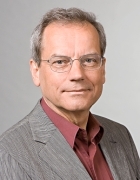
Prof. Dr. Harald Friedrich
Academic Career and Research Areas
The research of Prof. Friedrich (1947- 2017) centered on the description of atomic systems, especially in the anticlassical, extreme quantum regime, which is of crucial relevance for current research in ultra-cold atoms and molecules. His particular interests included near-threshold scattering and quantum reflection, as well asuniversal quantization rules for highly excited, weakly bound states.
Raised in Australia, Prof. Friedrich studied physics in Kiel and Freiburg. After receiving his doctorate in 1974 at the University of Münster, he received a German Research Foundation (DFG) grant to study at Oxford University. He completed his lecturer qualification in nuclear physics (1980) in Münster. Afterward, he received a Heisenberg grant to attend the California Institute of Technology (Caltech) from 1981 to 1983, where he turned his attention to atomic physics. In 1990, he published a textbook on theoretical atomic physics, which is now in its second German edition and third English edition. Before becoming a professor at TUM (1987), he lectured at the University of Münster, Caltech, Ludwig-Maximilian-Universität München and the University of Tübingen. He also spent periods at the Institute for Theoretical Atomic Physics at the Harvard-Smithsonian Center for Astrophysics and the Australian National University in Canberra.
Key Publications
Friedrich H, Trost J: "Working with WKB waves far from the semiclassical limit". Physics Reports. 2004; 397: 359-449.
Friedrich H, Jacoby G, Meister CG: "Quantum reflection by Casimir-van der Waals potential tails". Physical Review A. 2002; 65: 032902.
Friedrich H, Wintgen D: "The hydrogen atom in a uniform magnetic field — an example of chaos". Physics Reports. 1989; 183: 37-79.
Buck B, Friedrich H, Wheatley C: "Local potential models for the scattering of complex nuclei", Nuclear Physics. 1977; A275: 246-268.
If you wish your profile to be changed or updated please contact Franz Langer.